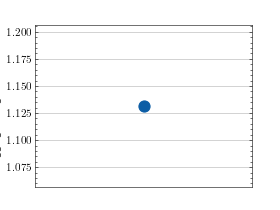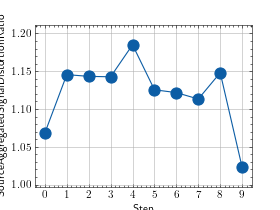Source Aggregated Signal-to-Distortion Ratio (SA-SDR)¶
Module Interface¶
- class torchmetrics.audio.sdr.SourceAggregatedSignalDistortionRatio(scale_invariant=True, zero_mean=False, **kwargs)[source]¶
Source-aggregated signal-to-distortion ratio (SA-SDR).
The SA-SDR is proposed to provide a stable gradient for meeting style source separation, where one-speaker and multiple-speaker scenes coexist.
As input to
forwardandupdatethe metric accepts the following inputpreds(Tensor): float tensor with shape(..., spk, time)target(Tensor): float tensor with shape(..., spk, time)
As output of forward and compute the metric returns the following output
sa_sdr(Tensor): float scalar tensor with average SA-SDR value over samples
- Parameters:
Example
>>> import torch >>> from torchmetrics.audio import SourceAggregatedSignalDistortionRatio >>> g = torch.manual_seed(1) >>> preds = torch.randn(2, 8000) # [..., spk, time] >>> target = torch.randn(2, 8000) >>> sasdr = SourceAggregatedSignalDistortionRatio() >>> sasdr(preds, target) tensor(-41.6579) >>> # use with pit >>> from torchmetrics.audio import PermutationInvariantTraining >>> from torchmetrics.functional.audio import source_aggregated_signal_distortion_ratio >>> preds = torch.randn(4, 2, 8000) # [batch, spk, time] >>> target = torch.randn(4, 2, 8000) >>> pit = PermutationInvariantTraining(source_aggregated_signal_distortion_ratio, ... mode="permutation-wise", eval_func="max") >>> pit(preds, target) tensor(-41.2790)
- plot(val=None, ax=None)[source]¶
Plot a single or multiple values from the metric.
- Parameters:
val¶ (
Union[Tensor,Sequence[Tensor],None]) – Either a single result from calling metric.forward or metric.compute or a list of these results. If no value is provided, will automatically call metric.compute and plot that result.ax¶ (
Optional[Axes]) – An matplotlib axis object. If provided will add plot to that axis
- Return type:
- Returns:
Figure and Axes object
- Raises:
ModuleNotFoundError – If matplotlib is not installed
>>> # Example plotting a single value >>> import torch >>> from torchmetrics.audio import SourceAggregatedSignalDistortionRatio >>> metric = SourceAggregatedSignalDistortionRatio() >>> metric.update(torch.rand(2,8000), torch.rand(2,8000)) >>> fig_, ax_ = metric.plot()

>>> # Example plotting multiple values >>> import torch >>> from torchmetrics.audio import SourceAggregatedSignalDistortionRatio >>> metric = SourceAggregatedSignalDistortionRatio() >>> values = [ ] >>> for _ in range(10): ... values.append(metric(torch.rand(2,8000), torch.rand(2,8000))) >>> fig_, ax_ = metric.plot(values)

Functional Interface¶
- torchmetrics.functional.audio.sdr.source_aggregated_signal_distortion_ratio(preds, target, scale_invariant=True, zero_mean=False)[source]¶
Source-aggregated signal-to-distortion ratio (SA-SDR).
The SA-SDR is proposed to provide a stable gradient for meeting style source separation, where one-speaker and multiple-speaker scenes coexist.
- Parameters:
- Return type:
- Returns:
SA-SDR with shape
(...)
Example
>>> import torch >>> from torchmetrics.functional.audio import source_aggregated_signal_distortion_ratio >>> g = torch.manual_seed(1) >>> preds = torch.randn(2, 8000) # [..., spk, time] >>> target = torch.randn(2, 8000) >>> source_aggregated_signal_distortion_ratio(preds, target) tensor(-41.6579) >>> # use with permutation_invariant_training >>> from torchmetrics.functional.audio import permutation_invariant_training >>> preds = torch.randn(4, 2, 8000) # [batch, spk, time] >>> target = torch.randn(4, 2, 8000) >>> best_metric, best_perm = permutation_invariant_training(preds, target, ... source_aggregated_signal_distortion_ratio, mode="permutation-wise") >>> best_metric tensor([-37.9511, -41.9124, -42.7369, -42.5155]) >>> best_perm tensor([[1, 0], [1, 0], [0, 1], [1, 0]])
